Though few may argue that traveling is more about experiencing a city than it is about enjoying the hotel, some would beg to differ. After all, a hotel—whether it’s a boutiquey architectural relic with no more than 20 guest rooms or a sprawling space boasting more than one resident restaurant—has much more to offer than simply a place to spend the night. And, as much as jet-setters and locals alike appreciate a sleek, new build with all of the luxuries of an ultracontemporary resort, there’s something refreshing—even grounding—about living within walls that have been standing for centuries. Luckily, there’s no shortage of historic hotels across the world.
From a 35-room former mansion in Kennebunkport, Maine, to the iconic 19th-century Ritz Paris, the storied lodgings on offer are palpable, to say the least. Whether you’re staying local or heading overseas, there’s hardly a greater escape than spending a few days in some of the world’s longest-established hotels.
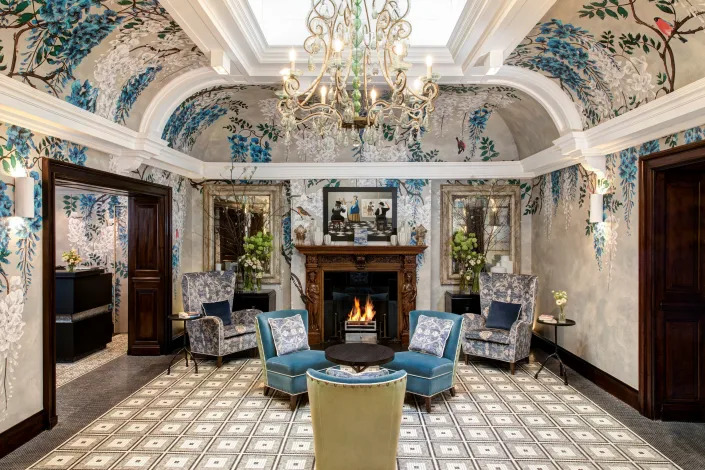
This posh hotel in Mayfair claims to be London’s first. It opened in 1837, the same year Queen Victoria ascended to the throne, and hosted visiting royalty, politicians, and other luminaries, including Alexander Graham Bell, who made the first telephone call in London from the hotel. It was purchased by Rocco Forte Hotels in 2003 and underwent a complete refurbishment spearheaded by the group’s design director Olga Polizzi. As you might expect, Brown’s does a fantastic afternoon tea in the elegant drawing room, where Queen Victoria herself liked to take her tea.

The plush Taormina hotel where the second season of The White Lotus was filmed started its life in the 14th century as a convent and was transformed into a hotel in 1896, when Taormina was a popular stop on the Grand Tour, with the addition of a Liberty-style structure. It immediately became a magnet for rich and famous guests, including Oscar Wilde, Truman Capote, Audrey Hepburn, and Princess Margaret. Four Seasons took over and, after a top-to-bottom renovation, reopened the hotel in 2021 with 111 luxurious rooms and suites, a clifftop infinity pool, spa, two restaurants, and a bar.
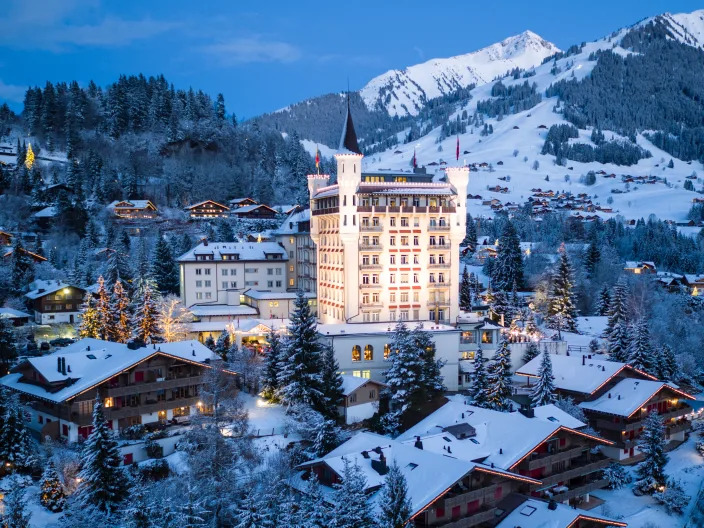
A visionary teacher opened the first luxury hotel in Gstaad, Switzerland, in 1913 thanks to the help of some investors. The Scherz-Bezzola family took over in 1938 and has run this member of the Leading Hotels of the World ever since, ensuring that this Swiss classic continues to thrive. Today guests can indulge in fondue and raclette at La Fromagerie, which served as a bunker that stored gold for the Union Bank of Switzerland during WWII, relax at the spacious spa, and dance the night away at GreenGo, which opened in 1971 and hosts internationally recognized DJs.
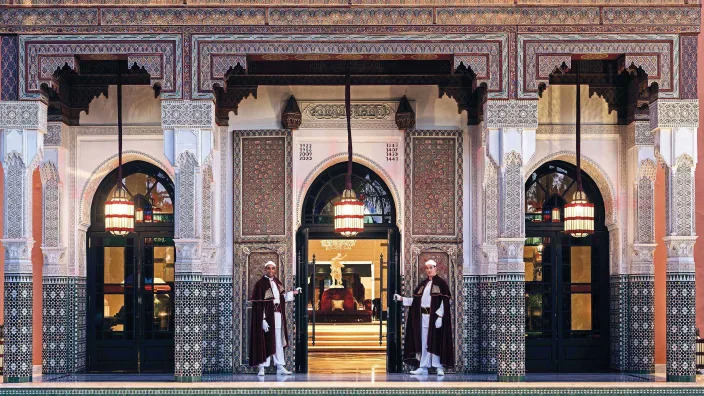
Marrakech’s palace hotel is celebrating its centenary this year. Opened in 1923 on the site of the 18th-century orchard of Sultan Mohammed Ben Abdallah, the hotel was designed in a style that combined traditional Moroccan elements, like zellij tiles and Berber rugs, with Art Deco furniture. It was a favorite home away from home for Winston Churchill, who used to spend winters there. Following a recent renovation by Jouin Manku, the bar he used to frequent now bears his name. A member of the Leading Hotels of the World, this luxurious property is especially famous for its gorgeous indoor pool and verdant gardens.
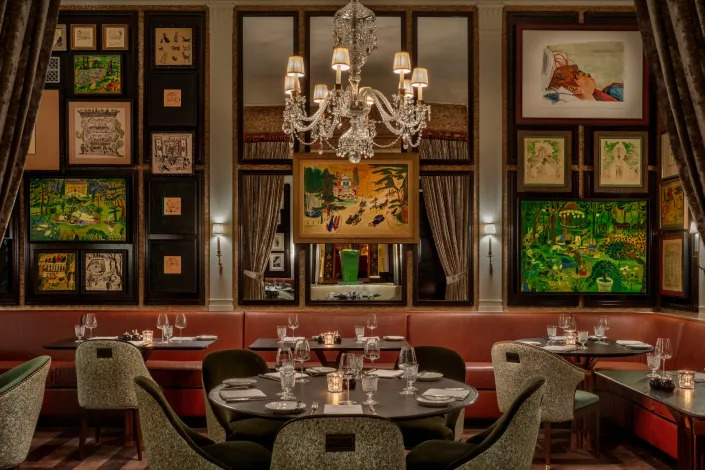
A beacon of the Upper East Side since 1930, the Carlyle is arguably New York City’s most iconic hotel. Designed by Dorothy Draper, the hotel’s remarkably influential Art Deco interiors feel oh-so–New York. It’s been updated and renovated several times over the years by Renzo Mongiardino, Tony Chi, Thierry Despont, and Alexandra Champalimaud. Bemelmans Bar, which features hand-painted murals by Ludwig Bemelmans, author of the Madeline series of children’s books, is a favorite spot among New Yorkers and celebrities like Bill Murray and George Clooney.

This Buenos Aires icon opened in 1932 as a luxury hotel for European visitors and was declared a national landmark in 2003. The hotel’s founder, Rafael de Miero, was inspired by his frequent trips to Paris and filled the hotel with elaborate parquetry, crystal chandeliers, marble columns, and furniture inspired by Louis XIV and Louis XVI. Recent renovations to this member of the Leading Hotels of the World added a rooftop pool and the Alvear Roof Bar, which join other outlets like the Alvear Grill, a contemporary Argentinian steakhouse, and the ornate Lobby Bar, which serves afternoon tea and cocktails.

Opened in 1924, this golf resort in the Scottish countryside calls itself “a glorious playground.” Its opening gala featured a musical performance that was broadcast on the BBC radio. It became a military hospital during WWII, but it reopened in 1947 and saw various improvements over the course of the 20th century. In 2015, it was purchased and subsequently refurbished by Ennismore, which is also behind Hoxton Hotels. Its new sister hotel, Gleneagles Townhouse, opened in Edinburgh last year. Both properties are members of the Leading Hotels of the World.
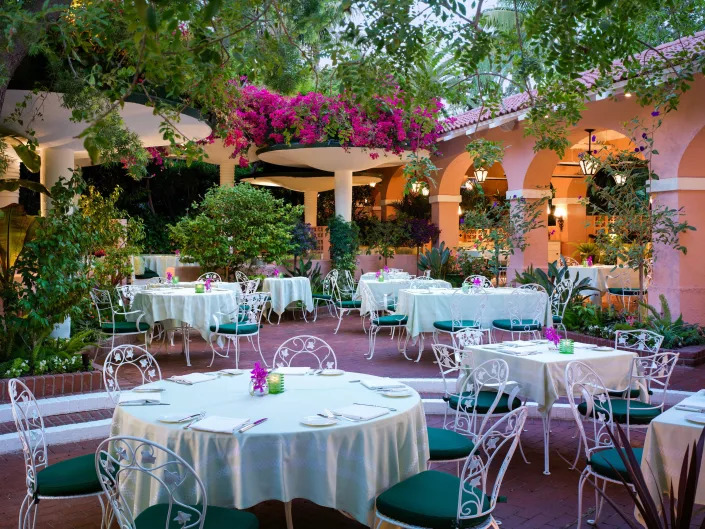
Believe it or not, the iconic Pink Palace actually predates the city of Beverly Hills. Its original owner and founder, Margaret Anderson, created it in 1912 as a place for people to stay while looking at property in the area. A woman ahead of her time, she used to say, “Guests are entitled to the best of everything regardless of cost!” Influential Black architect Paul R. Williams updated the hotel several times starting in the 1940s, bringing in the now-famous banana leaf wallpaper and updating its beloved script sign. It’s now part of the Dorchester Collection, which named Bungalow 5 after Elizabeth Taylor in honor of the movie star, who considered the hotel her home away from home.

Just a stone’s throw from the Brandenburg Gate, this opulent hotel created by Lorenz Adlon was inaugurated by Kaiser Wilhelm II in 1907 and is still one of Berlin’s best hotels. All but one wing was destroyed by a fire in 1945, but the hotel was rebuilt in 1997 with a design inspired by the original, except for the addition of two more floors. Traditional style reigns throughout the hotel, which has four restaurants and bars, including the two-time Michelin-starred Lorenz Adlon Esszimmer. It’s now a member of the Leading Hotels of the World.

Opened in 1912, this Belle Époque beauty is the toast of San Sebastián on Spain’s Basque Coast. Designed by architect Charles Mews, who was also responsible for the Ritz in Madrid and Paris, it represented the transformation of this sleepy fishing village into a glamorous resort town that attracted high society. It was named after Queen Maria Cristina, who was the first person to cross its threshold, and has hosted VIP guests ever since. The hotel was renovated in time for its centenary and today combines classic style with modern amenities.

Is there any hotel more iconic than the Ritz? The toast of Paris since hotelier César Ritz and Auguste Escoffier opened it in 1898, the palatial hotel (and member of the Leading Hotels of the World) on Place Vendôme is the epitome of classic luxury. Marcel Proust entertained guests in the restaurant, Coco Chanel lived in a suite, and Ernest Hemingway “liberated” it from the Nazis at the end of WWII. Following a $220-million, four-year renovation, the Ritz reopened in 2016 more glorious than ever, with the addition of the Salon Proust, the Hemingway Bar, a Chanel spa, and Escoffier cooking school.
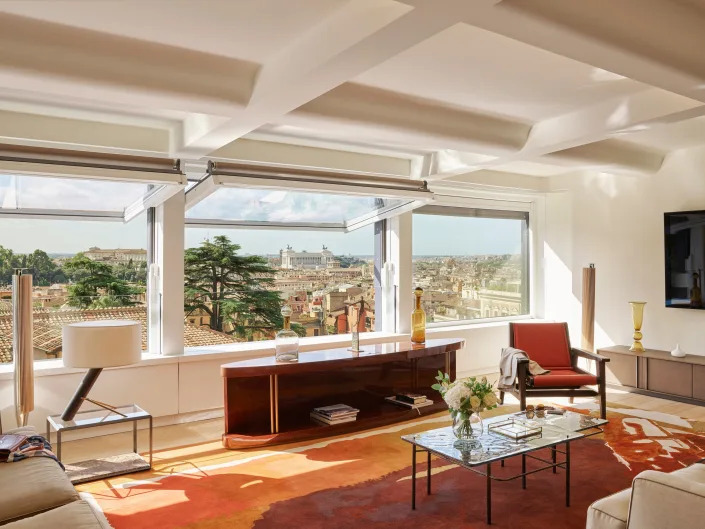
The Dorchester Collection spared no expense when renovating this grande dame opened in 1889 near Rome’s leafy Villa Borghese. The illustrious hotel was Rome’s first to have an elevator, electricity, heating, and running water. It was popular among aristocrats on the Grand Tour and later became a favorite haunt of filmmaker Federico Fellini. Two renowned design firms worked on the revamp: Bruno Moinard and Claire Bétaille were responsible for the lobby, which exudes unapologetic opulence with polished marble and gold coffered ceilings, and the rooms, swathed in cream and gold with pops of color. And Jouin Manku gave the two top-floor restaurants—the casual Il Giardino and the Michelin-starred La Terrazza—a more modern design.

Located in the Barrio de las Letras, this member of the Leading Hotels of the World is the oldest hotel in Madrid. When it opened in 1886, it was praised by the Spanish press as “one of the best hotels in Europe.” Thanks to a recent renovation by the Rockwell Group, it shines brighter than ever, with a sleek design that pays homage to its past and a vibrant lobby bar that serves excellent cocktails and tapas.

Five generations of the Fiorentino family have run this elegant hotel, part of the Leading Hotels of the World, overlooking the port of Sorrento, the gateway to Italy’s glamorous Amalfi Coast. It opened in 1834 and was named after Queen Victoria of Sweden, who often stayed there. The property exudes Old World elegance, with white jacketed waiters serving Aperol Spritzes to guests sitting on the terrace overlooking the port as strains of piano music waft through the air. Music is a crucial part of the hotel’s identity—it hosted famed tenor Enrico Caruso and, more recently, Lucio Dalla, both of whom have suites dedicated to them.

Located on Kongens Nytorv, in the center of Copenhagen, this five-star hotel traces its roots back to 1755, when a French servant, named Jean Marchal, and Maria Coppy, daughter of the royal chef, fell in love and opened a restaurant. Today, the hotel’s Michelin-starred restaurant is named after them. Part of the Leading Hotels of the World, the property underwent a massive renovation and reopened in 2013 with a sophisticated design that honors the hotel’s history while brining it firmly into the present.
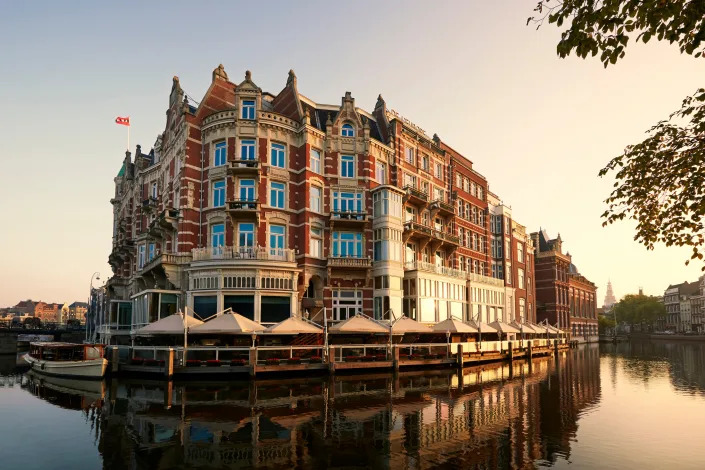
Opened in 1896 on the site of an inn that dates back to 1638, this member of the Leading Hotels of the World occupies a prime position on the Amstel River in the heart of Amsterdam. It has grown and modernized over the years, culminating in a recent renovation that amps up the hotel’s timeless allure. It added a new wing called ’T Huys (“house” in old Dutch), a creative hub with a bookstore, florist, spa, Trattoria Graziella, and suites that welcome artists in residence. The hotel is also home to a two-time Michelin-starred restaurant, Freddy’s Bar (named after owner Freddy Heineken), and more.

The Mandarin Oriental brand was born when the owners of the Mandarin Hotel in Hong Kong bought a 45% stake in the Oriental Hotel in Bangkok, which dates back to 1876 and was the first luxury hotel in the kingdom of Siam. For a while it was owned by Jim Thompson, an American stationed in Bangkok during WWII who stayed and revived the Thai silk industry. A recent renovation has given the luxurious property a new shine while preserving the integrity of historic spaces like the Authors’ Lounge, which was a favorite hangout of Somerset Maugham, Joseph Conrad, and Graham Greene. The award-winning Bamboo Bar has been a legendary watering hole since it opened in 1953.

Nestled within the snow capped mountains of St. Moritz, Switzerland, the legendary Badrutt’s Palace was founded in 1896 by Caspar Badrutt. In homage to his father’s background in woodworking, the luxurious hotel includes original wood ceilings, as well as meticulously maintained wooden cabinets and desks throughout the space. The result is an approachable, warm ambiance to enjoy while looking out through oversized windows towards the dramatic peaks of the Swiss Alps. The hotel’s history is also rooted in the fact that it, quite literally, invited the concept of winter resorts. In the late 19th century, tourists only visited northern regions in the summer months. But that all changed when the Badrutt’s invited weary tourists to visit during the winter by promising that if they didn’t enjoy their experience, the rooms would be free. The rest, as they say, is history.

Hong Kong’s oldest and most iconic hotel opened in 1928 and is still one of the city’s most beloved hotels to date. Expanded in 1994 with a 30-story tower that nearly doubled the amount of rooms, the property has retained its classic elegance while investing in the latest technology, like bedside electronic panels that let guests control the lights and temperature in the rooms. Eight restaurants and bars range from a Michelin-starred Cantonese restaurant to a modern European restaurant designed by Philippe Starck, but afternoon tea in the opulent lobby lounge is not to be missed.

Like quite a few coastal spots in the US, Kennebunkport Inn was a tea merchant’s private residence before opening its doors as a hotel in 1926. The inn, which sits on four acres along 400 feet of frontage on the Kennebunk River, still boasts quite a few of the former Federal-style home’s original elements, including four open fireplaces, a parlor, a library, a butler’s pantry, and a servants’ dining room. By 1961, Kennebunkport Inn had 10 guest rooms in the main building and 26 in the annex, which was constructed in the mid-20th century for locals and travelers alike.
Fast-forward to the turn of the century—2001, specifically—husband-and-wife hospitality experts Thomas Nill and Debra Lennon bought the inn and renovated it to its current glory: A 35-room homage to its former status as a private estate with a subtle infusion of contemporary flair. Not to mention, every Friday and Saturday evening until October 9, Kennebunkport Inn plays host to legendary performer Alan Cumming’s cabaret bar, Club Cumming.

Situated on Washington, DC’s famed 14th Street, the Hamilton Hotel, a classic European structure with a distinctly American presence, has managed to stand the test of time. Erected in 1851, the stately brick building served as a private school; but only a few years later, Admiral Horatio Bridge purchased the property and transformed it into a hotel dubbed Hamilton as a tribute to Mrs. Hamilton Holly, a family friend and the daughter of founding father Alexander Hamilton.
In 1921—60 years later—the Hamilton Hotel was sold to a group of local and New York–based bankers and businessmen who enlisted celebrated architect Jules Henri de Sibour to oversee the hotel’s much-needed renovations. The French creative incorporated the hotel’s now famous Beaux Arts and Art Deco elements, transforming the 326-room hotel into the stylish haven the international metropolis desperately needed.

Built as private residences on St. James’s Place in the 17th century, the several structures that make up what is now The Stafford London have changed hands quite a few times. In fact, it was formerly Richmond Club Chambers, Green’s Private Hotel, and St. James’s Palace Hotel. In 1912, The Stafford opened its doors to guests who can book a room or suite in any of the hotel’s three charming buildings: the main house, the mews house, and carriage houses, where the English nobility’s thoroughbreds lived.
Though the hotel has been around for quite a lot—two world wars, the Titanic’s demise, and the longest-reigning monarch’s coronation—The Stafford London’s guest rooms and suites are a masterclass in charismatic contemporary design with jewel-toned tufted quilts, geometric-inspired wallpaper, and unique patterns at play in nearly every nook and cranny.

There is hardly a more coveted New York address than one on Park Avenue, and the circa 1931 Waldorf Astoria is proof. However, the Art Deco landmark that served as five-star living quarters to such A-listers as Cole Porter, Frank Sinatra, and the Duke and Duchess of Windsor wasn’t always on its famous block on Park Avenue. The original 13-story Waldorf Hotel was constructed on the site of William Waldorf Astor’s mansion at the corner of Fifth Avenue and 33rd Street in 1893, and, four years later, his cousin, John Jacob Astor IV (who died aboard the Titanic), built his own hotel, the Astoria Hotel on a neighboring site. In 1929, the hotel owners demolished the building because the general elite was headed northbound, so they sold the site to what would later house the Empire State Building. A different team of developers, builders, and investors bought the Waldorf Astoria name and brought it up from Park Avenue to 50th Street.
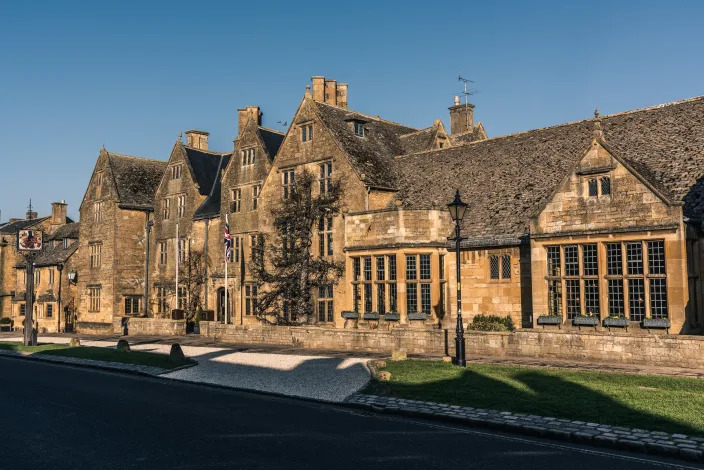
Set in the heart of the Cotswolds, a UNESCO World Heritage Site in the UK, the structure that constitutes The Lygon Arms is such an antique that its exact history is more or less unknown. That said, some circa 1377 documentary evidence implies that what used to be a proper coaching inn, dubbed The White Hart, stood where the current 86-room stone-front Tudor-style hotel does today. And in 1620, a man named John Trevis, perhaps the building’s then owner, stonemason, or maybe a local benefactor who sought to preserve his legacy long beyond his death, carved his name into the wall in the structure’s entry. Today, however, its deed rests in the capable hands of Iconic Luxury Hotels Ltd., who’ve honored the former inn’s 650-year history in more ways than one.
With charming guest rooms and suites spread across the main house, annex, courtyard, and cottage, there’s hardly a shortage of places to spend the night. Not to mention, the accommodations are just as luxurious for guests’ dogs, who can nap on and keep the Le Chameau dog bed that will be waiting in the room for them upon arrival.
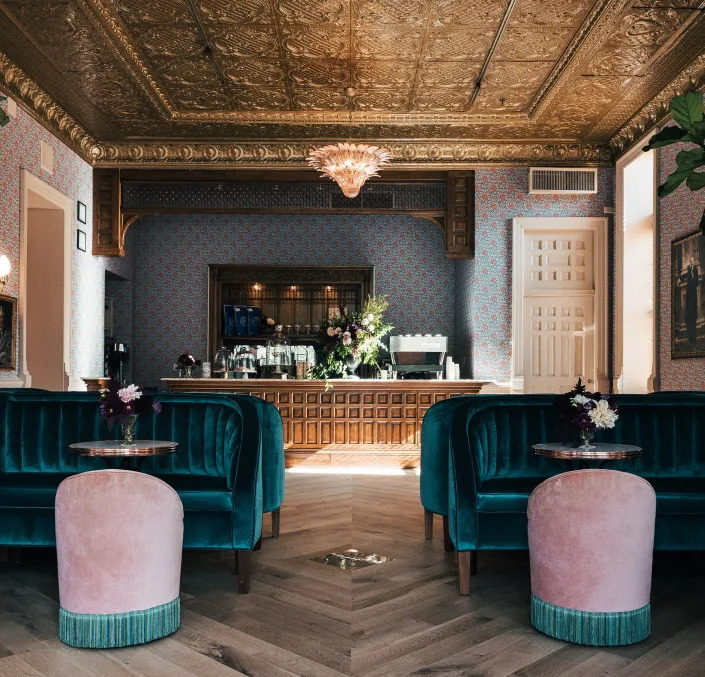
If there is one hotel that understands the value of timing, it is Aspen’s Hotel Jerome, which swung open its doors during the peak of the town’s silver rush in 1889. Though each of the 99 guest rooms is luxe in its own right, the two 2,000-square-foot three-bedroom residential penthouses are like sprawling mountain-side apartments that come complete with their own private elevators and outdoor terraces.
The hotel may be more than 130 years old, but it’s not quite done adapting to the times. Case in point: Matt Moinian and Ken Fulk’s stylish coffee concept, Felix Roasting Co., just opened, offering a maximalist yet refined space to the already glamorous outpost.

Built in 1845 as a family residence by Jared Coffin, one of Nantucket’s wealthiest shipowners during the heyday of the whaling industry, the classic New England mansion now serves as a boutique hotel on the island’s powdery sand shores. Though much of the original structure has been expertly maintained, it’s had a bit of work done over the years: In 1857, the new owner, local businessman and collector of customs for the District of Nantucket, Eben W. Allen, constructed a three-story addition housing 16 bedrooms; and in 1961, the Nantucket Historical Trust completely renovated the estate and reopened it as the Jared Coffin House. With 48 rooms spread across two buildings, including the original residence and a neighboring one, the Daniel Webster house, there is definitely plenty of space to spread out.

For anyone who wants an authentically delicious taste of Southwestern life, Tanque Verde Ranch should be first on your travel list. This rustic spot in Tucson has been up and running since 1868, when a man named Don Emilio Carrillo moved his family to the area. When the patriarch passed away, he left his beloved ranch to his son, who assumed leadership for a few years before selling his family’s property to a cattleman named Jim Converse in the mid 1920s. Under Converse’s innovative hand, the ranch boomed, nearly forcing Converse to build more and better lodgings than those that stood on the 19th-century property. By 1928, Tanque Verde Ranch was a fully operational hotel with 69 guest rooms. Converse sold the ranch to the current owners, the Cote family.

Venice’s most legendary hotel resides in a 15th-century palazzo on the Grand Canal that became the home of the Doge of Venice, Andrea Gritti, before being transformed into a luxurious hotel in the early 1800s. Stepping inside, you can feel history come alive. With leaded glass windows, damask wallpaper, antiques, Rubelli fabrics, and glass chandeliers, it’s opulent but not fussy. The top suites are dedicated to illustrious past guests, like Somerset Maugham and Ernest Hemingway. The hotel even has its own Riva speedboat so guests can cruise the lagoon in style.
Source : YahooNews







